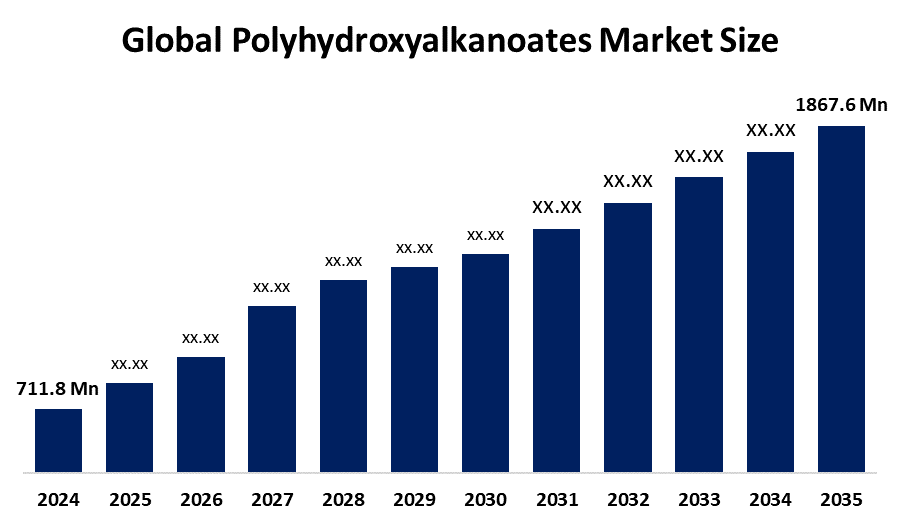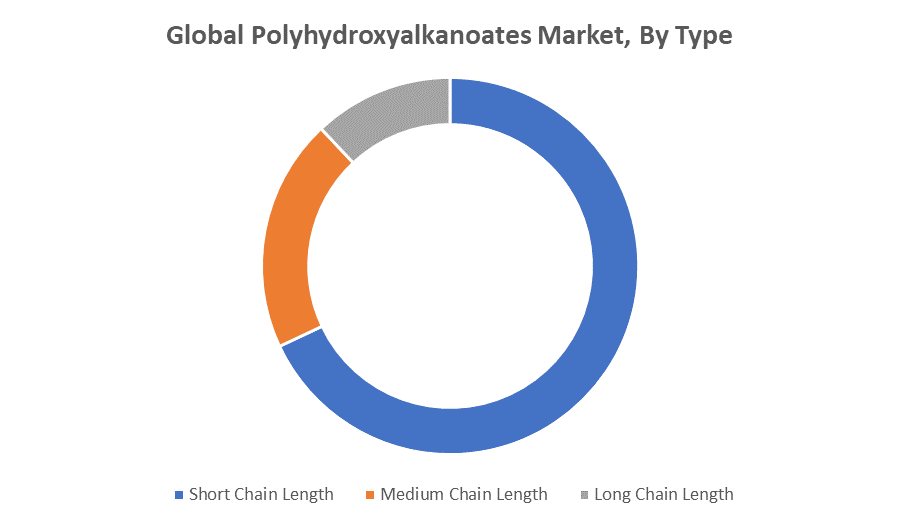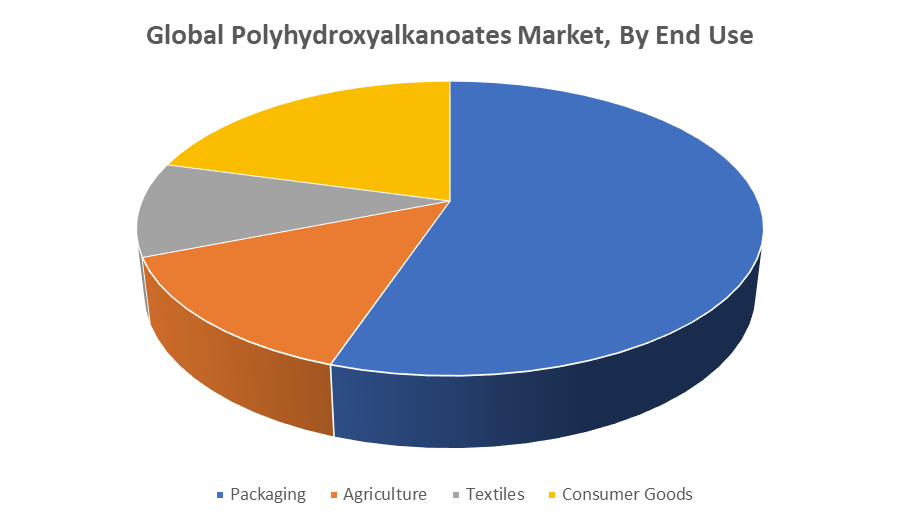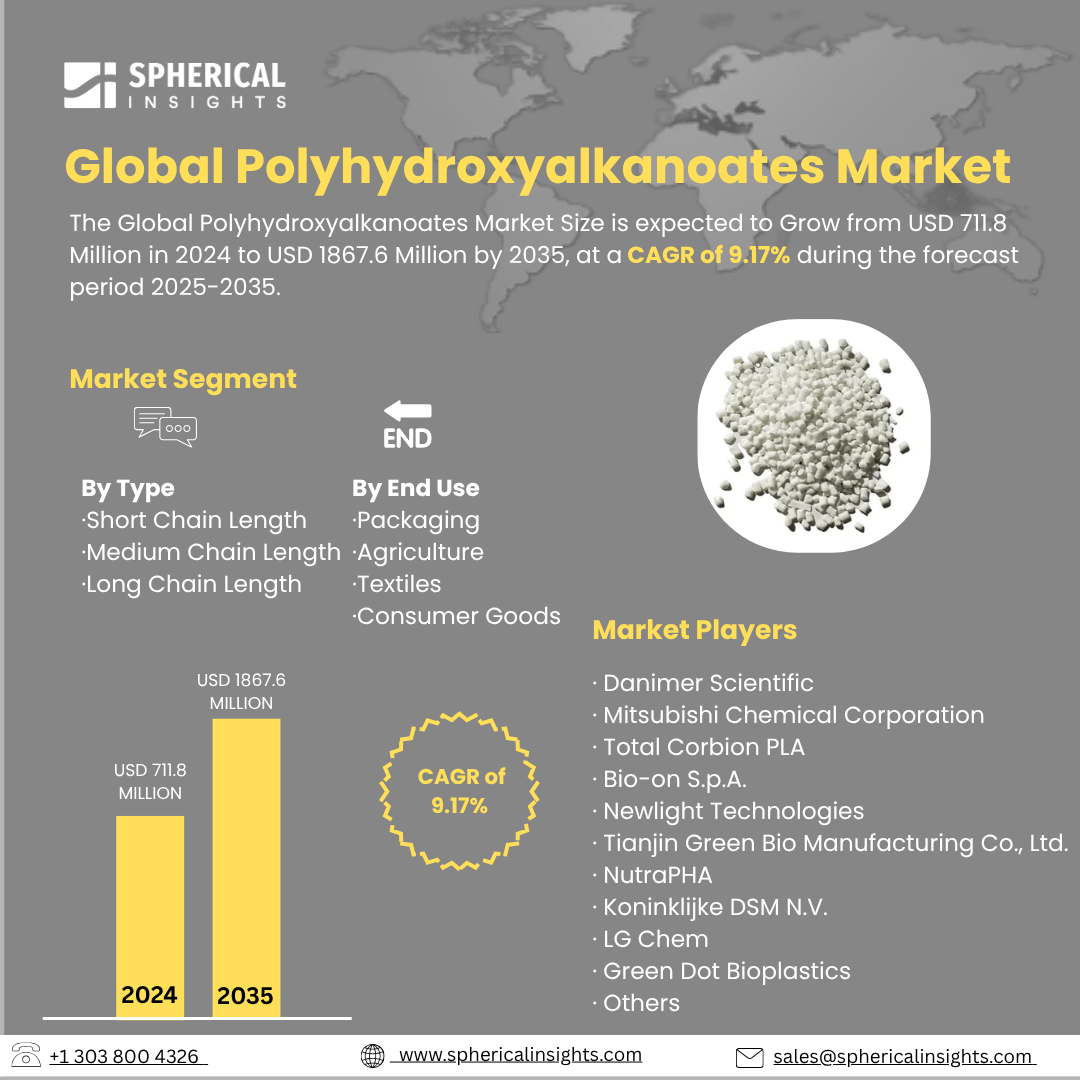Global Polyhydroxyalkanoates Market Insights Forecasts to 2035
- The Global Polyhydroxyalkanoates Market Size Was Estimated at USD 711.8 Million in 2024
- The Market Size is Expected to Grow at a CAGR of around 9.17% from 2025 to 2035
- The Worldwide Polyhydroxyalkanoates Market Size is Expected to Reach USD 1867.6 Million by 2035
- North America is expected to grow the fastest during the forecast period.

Polyhydroxyalkanoates Market
Polyhydroxyalkanoates are biodegradable polymers synthesized by microorganisms as energy reserves, offering a sustainable alternative to conventional plastics. These bioplastics are versatile and used across various industries, including packaging, agriculture, medical devices, and the automotive sector. PHAs are highly valued for their environmental benefits, as they degrade naturally, reducing long-term pollution caused by conventional plastic waste. The increasing focus on sustainable materials and the push for environmentally-friendly solutions have contributed to the growing adoption of PHAs in multiple applications. Produced from renewable resources like plant sugars or waste biomass, PHAs offer a renewable and eco-conscious solution to plastic pollution. With technological advancements in microbial fermentation and polymer production, PHAs are becoming more accessible and commercially viable, making them a key player in the shift towards a circular economy. The market is positioned for significant growth as industries continue to explore alternatives to petroleum-based plastics.
Attractive Opportunities in the Polyhydroxyalkanoates Market
- There is significant potential in exploring new feedstocks for PHA production, such as waste oils, agricultural residues, and algae. This could reduce dependency on food-based crops, thereby addressing sustainability concerns and reducing production costs.
- Partnerships between research institutions and manufacturers could lead to innovations in PHA production, such as improving the efficiency of microbial fermentation processes, enhancing the properties of PHAs, and lowering costs.
Global Polyhydroxyalkanoates Market Dynamics
DRIVER: Rising environmental concerns and the increasing demand for sustainable materials
The growth of the global polyhydroxyalkanoates market is largely driven by rising environmental concerns and the increasing demand for sustainable materials. With plastic pollution becoming a critical issue worldwide, PHAs present a biodegradable alternative to conventional petroleum-based plastics, making them a preferred choice for environmentally conscious industries. Furthermore, stricter environmental regulations and policies, such as plastic bans and extended producer responsibility (EPR) laws, are encouraging manufacturers to seek sustainable solutions like PHAs. Technological advancements in PHA production processes, such as microbial fermentation and improved raw material utilization, have also lowered production costs, making PHAs more commercially viable. Additionally, increasing awareness among consumers and businesses about the ecological impact of plastic waste has led to greater adoption of biodegradable and compostable materials. As industries in packaging, agriculture, and medical sectors explore greener alternatives, PHAs are positioned as a leading solution for reducing dependence on non-renewable plastics.
RESTRAINT: Scaling up PHA production to meet global demand is still a work in progress
While polyhydroxyalkanoates present an eco-friendly alternative to conventional plastics, several challenges impede their broader adoption. One of the primary obstacles is the relatively high production cost, which remains significantly higher than that of traditional plastics. PHA production relies on complex biotechnological processes like microbial fermentation, requiring expensive equipment and a steady supply of renewable feedstock, which increases costs. Additionally, scaling up PHA production to meet global demand is still a work in progress, with existing infrastructure struggling to achieve cost-effective mass production. The limited availability of raw materials, such as agricultural waste and plant sugars, also presents a supply chain challenge. Furthermore, many small to medium-sized enterprises (SMEs) lack awareness of the benefits of PHAs, slowing market adoption. Finally, the rise of alternative biodegradable materials, such as polylactic acid (PLA), intensifies competition, posing a threat to the market share of PHAs.
OPPORTUNITY: Collaborations between research institutions and manufacturers
One significant opportunity lies in the development of new and diverse feedstocks for PHA production, such as waste oils, agricultural residues, or algae. This could help reduce the dependency on food-based crops and lower production costs, making PHAs more accessible. Another opportunity exists in the expansion of PHA applications. Beyond traditional uses in packaging and medical sectors, there is growing potential in industries like textiles, 3D printing, and electronics, where biodegradable plastics could provide sustainable alternatives. Collaborations between research institutions and manufacturers can also lead to breakthroughs in improving production efficiency and scaling up operations. Moreover, the increasing demand for "circular economy" practices presents an opportunity for PHA producers to offer products that can be easily recycled or composted, appealing to businesses and consumers alike. Finally, with global governments pushing for carbon-neutral goals, PHAs could gain more attention and funding in sustainable technology initiatives.
CHALLENGES: Educating both businesses and consumers
One of the most pressing challenges is the variation in the physical properties of PHAs, which can affect their performance across different applications. Depending on the microorganism used for production and the feedstock, PHAs can have different levels of strength, flexibility, and durability, making it difficult to standardize the material for mass production. Additionally, the market faces challenges in developing efficient waste management systems for PHA products once they have reached the end of their lifecycle. Although PHAs are biodegradable, ensuring their complete degradation in different environmental conditions can be complex. Another challenge is the need for substantial investment in research and development to enhance PHA properties, lower production costs, and develop scalable processes. Finally, educating both businesses and consumers about the long-term benefits of PHAs is essential for broadening acceptance and integration into various industries.
Global Polyhydroxyalkanoates Market Ecosystem Analysis
The global polyhydroxyalkanoates market ecosystem involves microbial producers, biotech companies, raw material suppliers, and end-user industries like packaging, agriculture, and healthcare. Governments and regulatory bodies promote sustainable alternatives through policies and regulations. Research institutions drive innovation in production processes, while investors fund key players in scaling technology. PHA manufacturers and distributors ensure supply to industries, and the recycling sector handles end-of-life biodegradation. Collaboration among these stakeholders is essential for advancing PHA technology and fostering a circular economy
Based on the type, the short chain length segment led the market with the major revenue share over the forecast period

Short-chain length PHAs, typically composed of 3 to 5 carbon atoms, are highly versatile and cost-effective, making them suitable for a wide range of applications, particularly in packaging, biomedical, and agricultural industries. Their superior properties, such as flexibility, high tensile strength, and easier processing, contribute to their popularity. Additionally, short-chain PHAs biodegrade quickly, offering significant environmental advantages, further driving their adoption. As production technologies improve and economies of scale are realized, the short-chain length segment is poised for continued growth, appealing to manufacturers and consumers seeking sustainable alternatives to conventional plastics.
Based on the end use, the packaging segment led the market with the leading revenue share during the forecast period

PHAs' biodegradable and compostable properties make them an ideal alternative to traditional plastics in packaging applications, which is a major driver of market growth. As consumer demand for sustainable packaging solutions increases, PHAs are being increasingly adopted in food and beverage packaging, as well as in products like bags, wraps, and containers. With growing environmental concerns and stricter regulations on plastic waste, the packaging industry is shifting towards more eco-friendly materials. This trend is expected to drive significant growth in the PHA packaging segment, as businesses seek to meet regulatory requirements and consumer preferences for sustainable, non-toxic alternatives.
Europe is anticipated to hold the largest market share of the polyhydroxyalkanoates market during the forecast period
Europe is anticipated to hold the largest market share of the polyhydroxyalkanoates (PHA) market during the forecast period. This can be attributed to the region's strong regulatory framework and commitment to sustainability, which has led to a higher adoption of biodegradable alternatives to conventional plastics. European countries have implemented stringent plastic waste reduction policies, including plastic bags and extended producer responsibility (EPR) programs, driving demand for eco-friendly materials like PHAs. Additionally, Europe is home to several leading bioplastics manufacturers and research institutions, fostering innovation and production scalability. The growing consumer awareness about environmental issues, combined with the rising demand for sustainable packaging, agriculture, and medical applications, further boosts the market in this region. With robust investments in research and development and increasing regulatory pressure on plastic usage, Europe is well-positioned to lead the PHA market in the coming years.
North America is expected to grow at the fastest CAGR in the polyhydroxyalkanoates market during the forecast period
North America is expected to grow at the fastest CAGR in the polyhydroxyalkanoates (PHA) market during the forecast period. This growth can be attributed to the region's increasing focus on sustainability and environmental responsibility, coupled with strong support from both government and private sectors. North America is home to numerous innovative biotech companies that are advancing PHA production technologies, driving down costs and improving scalability. Additionally, the growing awareness among consumers and businesses about the environmental impact of traditional plastics is pushing demand for biodegradable alternatives. Regulatory policies, such as extended producer responsibility (EPR) laws and bans on single-use plastics, are also accelerating the shift toward more sustainable materials. With significant investments in research and development, along with rising adoption of PHAs in packaging, agriculture, and medical sectors, North America is poised to experience rapid market expansion in the coming years.
Recent Development
- In February 2024, Danimer Scientific announced progress in refining its PHA production technology, leveraging microbial fermentation and non-food feedstocks like waste biomass to reduce production costs.
Key Market Players
KEY PLAYERS IN THE POLYHYDROXYALKANOATES MARKET INCLUDE
- Danimer Scientific
- Mitsubishi Chemical Corporation
- Total Corbion PLA
- Bio-on S.p.A.
- Newlight Technologies
- Tianjin Green Bio Manufacturing Co., Ltd.
- NutraPHA
- Koninklijke DSM N.V.
- LG Chem
- Green Dot Bioplastics
- Others
Market Segment
This study forecasts revenue at global, regional, and country levels from 2020 to 2035. Spherical Insights has segmented the polyhydroxyalkanoates market based on the below-mentioned segments:
Global Polyhydroxyalkanoates Market, By Type
- Short Chain Length
- Medium Chain Length
- Long Chain Length
Global Polyhydroxyalkanoates Market, By End Use
- Packaging
- Agriculture
- Textiles
- Consumer Goods
Global Polyhydroxyalkanoates Market, By Regional Analysis
- North America
- Europe
- Germany
- UK
- France
- Italy
- Spain
- Russia
- Rest of Europe
- Asia Pacific
- China
- Japan
- India
- South Korea
- Australia
- Rest of Asia Pacific
- South America
- Brazil
- Argentina
- Rest of South America
- Middle East & Africa
- UAE
- Saudi Arabia
- Qatar
- South Africa
- Rest of the Middle East & Africa






